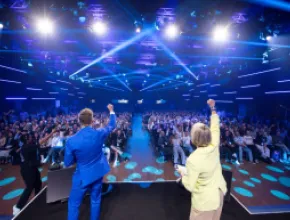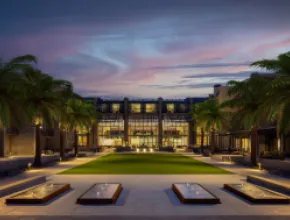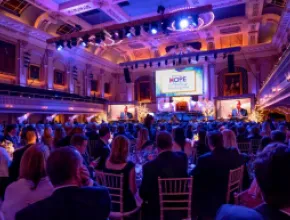Take a good look at the city of Lincoln, Neb., and you start to notice a few things. Its skyline is dominated by the graceful, gold-domed Nebraska State Capitol building, the tallest structure in town.
A new arena, hotels and a University of Nebraska campus are all under construction, contributing to an almost comically low unemployment rate. People young and old flock to the ever-growing Haymarket arts and entertainment district, regardless of whether it’s a weekday or weekend. And a steady influx of people and jobs means that Lincoln has exited every decade since 1920—every decade—with roughly 20,000 more citizens than when it entered.
So what accounts for Lincoln’s success and growth regardless of boom or bust, in a city that might otherwise have become a slightly boring state capital-slash-college town?
For starters, Lincoln’s residents probably disagree on many issues, but they seem unified around the idea of welcoming everyone and making sure there are enough jobs and interesting things to do here, says Derek Feyerherm, director of sales and operations at the Lincoln CVB.
“We have a strong public-private development partnership that identifies companies that could relocate to Lincoln, plus working with existing businesses here,” Feyerherm says.
This group, the Lincoln Partnership for Economic Development (LPED), is a relentless cheerleader for an already business-friendly town that racked up quality-of-life awards pretty much effortlessly in 2011: Top 10 places to buy a home (ABC News), eighth most-affordable place to live (MSN), third-healthiest city (Men’s Health), fourth-best place to raise a family, even an “A” for air quality from the notoriously hard to please American Lung Association.
Of course, Lincoln has some native advantages as well, such as rock-steady employment courtesy of the state government.
“Not only are we the state capital, we also have the University of Nebraska-Lincoln campus,” Feyerherm says.
“They’ll be expanding onto an Innovation Campus that will provide new research and job opportunities, so that’s more opportunities for students just graduating college.”
More construction. More jobs. Just another day in Lincoln.
Yet planners will like that Lincoln is modestly priced compared with other regional cities, with rates and occupancy that have stayed the same, plus or minus a percentage point, even through the recent recession, according to Feyerherm.
“We might not have the beaches and oceans, but we don’t have rates that are outlandish,” he says. “It’s easy on the pocketbook, [and] your board is not going to gig you for coming to Lincoln. We’re really a safe community.”
As for the convention market, Feyerherm says Lincoln’s largest convention spaces are attached to hotels. These include the Cornhusker (a Marriott property whose ownership was changing but whose new flag was unknown at press time), Embassy Suites Lincoln and Holiday Inn Lincoln-Downtown, as well as a host of additional limited-service chain properties.
Lincoln can host much larger groups, however, when breakout rooms aren’t an issue—such as when a group needs one big space, according to Feyerherm.
“Lincoln has been increasing its marketing to religious planners,” he says. “They just need a large gathering place for their general assemblies. We’ve been successful in hosting ministry groups of 5,000 to 6,000. But next fall our new arena will open and that will have 16,000 permanent seats, plus you could put more on the floor if you had to.”
Which brings us to the Haymarket district and the new West Haymarket Development. The Haymarket area is Lincoln’s downtown showcase, an area of older warehouses east of the main railroad depot that had been allowed to slide downhill. Thanks to LPED—there’s that public-private cooperation again—and others, it has slowly transformed into an area thick with shops, galleries, restaurants and entertainment venues, a process that hasn’t been hurt by proximity to the University of Nebraska-Lincoln (UNL) campus and two major highways.
Lincoln’s street grid makes it easy to navigate the Haymarket area’s delis, brewpubs and ethnic restaurants serving Indian, Italian, Japanese and Mexican delicacies. Once visitors are adequately fueled up they can move on to tackling the Haymarket’s myriad art galleries and live entertainment venues.
But since “We could always make it better” seems to be Lincoln’s informal motto, the West Haymarket development is now under way. The West Haymarket project will transform 400 acres of this corner of the city yet again. Centered on the Pinnacle Bank Arena, which is scheduled to open in September 2013, West Haymarket will bring Lincoln’s game up to that of famed arts and entertainment districts such as Kansas City’s Power & Light District or Louisville’s Fourth Street Live.
Three new hotels are also under construction in the West Haymarket area, including a Courtyard by Marriott that opens this fall, a Hilton Garden Inn slated to open in summer 2013 and a third hotel that is as yet unflagged. New retail and restaurant spaces will abound, and Lincoln’s Amtrak station will be torn down and an all-new station built nearby with a translucent glass and steel skylight above its main lobby.
In addition, the planned Breslow Ice Center will feature two NHL-standard ice hockey rinks and serve as the new home of the UNL men’s and women’s hockey teams.
The pedestrian center of West Haymarket will be a big community plaza called The Yard, an open outdoor area surrounded by bars and restaurants and a giant three-sided TV screen for entertainment. It is scheduled to open in late 2013. Project managers have also issued a call to the community to contribute concepts for public art.
Meanwhile, existing cultural facilities in Lincoln include the 1920s Rococo Theatre, which besides being a versatile performance space offers Barrymore’s, a backstage cocktail bar that retains the lighting board and pulleys from its earlier role in theatrical productions. If a planner’s group can’t get tickets for Huskers football, the Rococo is happy to project the game for groups on-demand. In addition, the Lied Center for the Performing Arts offers a 2,192-seat auditorium as well as several smaller spaces, including a black box theater that’s ideal for anything from dance recitals to receptions for 250.
Then there are Lincoln’s one-of-a-kind museums. Each focuses on a single theme—telephones, roller skating, Nebraska history and quilting—which can make for a deep dive into a single subject or an enjoyable day moving from venue to venue and topic to topic.
Other large meetings-friendly venues in town include the multiuse Pershing Center, which has 44,000 square feet of space and is popular for sports events requiring seating for up to 7,000; the Ice Box, which seats 5,000 and is home to the US Hockey League’s Lincoln Stars; and the Lancaster Event Center, featuring 400,000 square feet of space.
Paul D. Kretkowski writes frequently about travel, food and sports. He is also the founder of Beacon, a blog about foreign policy.






